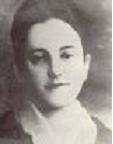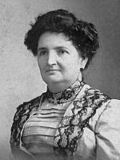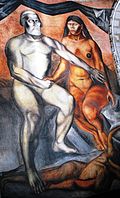List of 999 women of the Heritage Floor / Sacajawea
This list describes the place setting for Sacajawea on the table of Judy Chicago's art installation The Dinner Party . It is part of the list of 999 women on the Heritage Floor who are assigned to the respective place settings on the table. The names of the 999 women are on the tiles of the Heritage Floor, which is arranged below the table and belongs to the art installation.
description
The installation consists of a three-sided table, each with 13 historical or mythological personalities, thus a total of 39 people, from prehistory to the women's rights movement . These people were assigned a place setting at the table, consisting of an individually designed table runner, an individually designed plate, a goblet, knife, fork, spoon and serviette. The first page of the table is devoted to prehistory up to the Roman Empire , the second to Christianization up to the Reformation and the third from the American Revolution to the women's movement. Each place setting on the table is assigned additional personalities who have received an entry on the tiles of the Heritage Floor, which occupies the space under the table and the center of the space between the sides of the table. This list records the personalities assigned to the Sacajawea table setting. Your seat is on the third side of the table.
Hints
In addition to the names as they are used in German transcription or in scientific usage, the list shows the spelling chosen by Judy Chicago on the tiles.
The information on women who do not yet have an article in the German-language Wikipedia is referenced by the individual references listed under comments . If individual information in the table is not referenced via the main article, additional individual references are given at the relevant point. If there are any discrepancies between the information provided in Wikipedia articles and the descriptions of the work of art on the Brooklyn Museum website , this will also be indicated under Comments.
Place setting for Sacajawea
Sacajawea was born in the Lemhi River Valley, Idaho around 1788. Her name means "bird woman". Sacajawea was an Indian from the northern Shoshone tribeand lived as a slave with the Hidatsa Indians after she was abducted by them when she was about 10 years old. From these she was sold to the French-Canadian fur hunter Toussaint Charbonneau together with another slave named “Otterfrau”. When in 1804 the Lewis and Clark Expedition,commissionedby President Thomas Jefferson to explore the Louisiana colony , which was bought in 1803and, ifpossible, the area as far as the Pacific Ocean , arrived at the Hidatsa, Charbonneau was hired as an interpreter . Sacajawea was also chosen to accompany the expedition as she spoke the Shoshone language. On the expedition, which started in April, Sacajawea took her baby Jean Baptiste , who was born in February,with her. William Clark mentions the baby several times in his journal, he later became the foster father of the child and ensured that it received an excellent international education.
Sacajawea not only accompanied the expedition as an interpreter and scout, she was also helpful in other ways for the success of the expedition. At first, her presence with the child alone was a sign for other Indians that the expedition would be peaceful, as Indians never took women or children on a campaign. She could help with the identification of plants and animals, a brother of Sacajawea was chief of a Shoshone division and could equip the group with horses. She also helped in other places.
Upon their return, Sacajawea and Charbonneau stayed with the Hidatsa. At the invitation of Clark, Sacajawea went to St. Louis about three years later . There Clark made sure that she got a piece of land and he paid for Jean Baptiste's education. In 1812 Sacajawea had a daughter named Lisette. Sacajawea died in Fort Manuel Lisa in December 1812 , presumably of typhus . Since Charbonneau was on a trade trip and the rumor arose that he had been killed by Indians, William Clark took over the guardianship of both children in 1813. There is no further information about Lisette, she probably died in childhood. Charbonneau returned from the wild four years later. Thanks to Clark, Jean Baptiste received an excellent education. He lived in Europe for years and visited Africa. He died under unexplained circumstances during the California gold rush .
After the expedition returned, the findings were enthusiastically received. Lewis and Clark became heroes, Sacajawea completely forgotten. That changed about 100 years later when Eva Emery Dye, a women's rights activist, researched women who had made significant contributions in the past.
The place setting for Sacajawea on the dinner party table is shaped by the use of the artistic and cultural tradition of the Shoshone tribe. Abstract geometric patterns were used by the women of the tribe while men created pictographic works. The plate is designed in yellow, ocher, blue and lavender tones. These shades were made from plants by the Shoshone. Chicago also includes the shapes of the butterfly and the triangle, which also occur in the Indian patterns, in the traditional Indian design, in order to create an authentic design. A cradle board and a cloth are attached to the plate, which indicate the situation in Sacajawea, which led the expedition with her baby on her back. The table runner is made of hand-tanned deerskin according to the tradition of the Plains Indians. Almost 40,000 opaque rocailles border the edges as stripes of pearls. They form a traditional Shoshonen motif. The name Sacajawea was embroidered on fabric under the deerskin. An asymmetrical neckline makes it visible and the initial letter "S" is surrounded by a complex pearl surround.
| Surname | Spelling on the tile | Date of birth | cultural spatial assignment | Remarks | image |
|---|---|---|---|---|---|
| Ana Betancourt | Ana Betancourt | 1832 | Cuba | She was a mambísa and was one of the first generation of Cuban feminists. |

|
| Anacaona | Anaconda | 1464 | Hispaniola | Queen of the Taíno people . Composer of ballads and poems. |

|
| Andrea Villarreal | Andres Villareal | 1881 | Mexico | Teacher, poet, work organizer and feminist who published La Mujer Moderna with her sister . | |
| Awashonks | Awashonks | 17th century | Wampanoag , New England | Things (chief) of the Sakonnet tribe in Rhode Island . Historical figure related to the colonial history of the USA. | |
| Candelaria Figueredo | Candelaria Figueredo | 1852 | Cuba | Cuban patriot who fought against Spain in the Cuban independence struggle. |

|
| Capillana | Capillana | 16th century | Peru | Peruvian ruler who befriended Spanish conquistadors . | |
| Carlota Matienzo | Carlota Matienzo | 1881 | Puerto Rico | Feminist and educator. Worked for educational reform and was one of the founders of two women's rights organizations. | |
| Ehyophsta | Ehyophsta | 18th century | United States | Warrior from the Cheyenne tribe who fought in the Battle of Beecher Island in 1868 and the Shoshone in the same year. She was also a member of a secret society made up entirely of Cheyenne women. | |
| Etelvina Villanueva y Saavedra | Saaredra Villanueva | 1897 | Bolivia | Bolivian poet and educator. Founder of the feminist group Legión Femenina de Educación Popular de America . | |
| Isabel de Guevara | Isabel de Guevara | 16th century | Spanish colonization of Latin America | One of the few European women to accept the offer of the Spanish Crown to take part in colonization missions during the first wave of the Spanish conquest and settlement of the New World. | |
| Isabel Le Brun de Pinochet | Isabel Pinochet | 1845 | Chile | She led the reform of girls' education in Chile. | |
| Josefa Ortiz de Domínguez | Josefa de Dominguez | 1773 | Mexico | National heroine who did a great job in the struggle for Mexico's independence from Spain . |

|
| Jovita Idár | Jovita Idar | 1885 | United States | Journalist, political activist and civil rights activist. She tried to promote the civil rights of Mexican Americans. | |
| Juana Inés de la Cruz | Juana de la Cruz | 1648 | Mexico | Nun and poet . |

|
| Ka'ahumanu | Kaahumanu | 1768 | Hawaii | Queen of Hawaii , strengthened the rights of Hawaiian women. |

|
| Laura Torres | Laura Torres | 19th century | Mexico | Journalist and founder of an early feminist organization. | |
| Luisa Moreno | Luisa Moreno | 1907 | Guatemala , United States | United States Labor Movement Leader, Social Activist, Organized Worker, carried out strikes, wrote leaflets in English and Spanish, and convened the 1939 Pueblos de Habla Española Congress , the "First National Latino Civil Rights Assembly." | |
| Magda Portal | Magda Portal | 1900 | Peru | Poet, feminist, author and political activist, was one of the founders of the Alianza Popular Revolucionaria Americana . | |
| Malinche | La Malinche | around 1505 | Mexico | Interpreter and later lover of the conquistador Hernán Cortés , played an important role in the campaign of conquest . |

|
| Maria Bartola | Maria Bartola | 16th century | Mexico | Aztec , is called the first woman historian in Mexico. | |
| María del Refugio García | Maria del Refugio Garcia | 1898 | Mexico | Women's rights activist. | |
| María Luisa Bombal | Maria Luisa Sanchez | 1910 | Chile | Writer, is one of the few women writers in Latin America whose work has received worldwide attention. |

|
| Maria Montoya Martinez | Maria Montoya Martinez | 1887 | United States | Native American artist, internationally renowned potter, studied traditional Pueblo pottery styles and techniques to create pieces that reflected the Pueblo culture's share of arts and crafts. | |
| Marie Aioe Dorion | Marie Iowa | around 1786 | United States | Sole female member of an overland expedition sent to the Pacific Northwest by the Pacific Fur Company in 1810 . | |
| Mary Musgrove | Mary Musgrove | around 1700 | New England | Important mediator Yamacraw - of English descent between the Muscogee and the English colonists. | |
| Nancy Ward | Nancy Ward | 1738 | Cherokee | A beloved Cherokee woman , which means that she has been allowed to sit on councils and make decisions with the chiefs and other beloved women . |

|
| Ofelia Uribe de Acosta | Ojelia Uribe de Acosta | 1900 | Colombia | Suffragette . | |
| Pocahontas | Pocahontas | around 1595 | New England | Mediator between the Virginia-Algonquin tribes and the English colonists . |

|
| Rosana Chouteau | Pink chouteau | 19th century | Osage | First female chief of the Osage Beaver group, the Osage in Oklahoma . | |
| Sarah Winnemucca | Sara Winnemucca | 1844 | Paiute | Indian politician and writer. |

|
| Teresa Villarreal | Teresa Villarreal | 1883 | Mexico / United States | Revolutionary leader on workers and feminist issues who supported the Partido Liberal Mexicano (PLM) during the Mexican Revolution of 1910–1917 . | |
| Weetamoo | Wetamoo | around 1635 | Wampanoag | She was the Sunksqua , also Sachem , the Pocasset Wampanoag. She had four husbands, the most famous of whom was Wamsutta , the eldest son of Massasoit , Sachem of Wampanoag and participant of the first Thanksgiving with the pilgrims. | |
| Xochitl | Xochitl | at 877 | Central Mexico | Toltec queen from 990 to 1040. She helped forge the Toltec state and legend has it that she died in battle. |

|
- Individual evidence
- ^ Brooklyn Museum: Sacajawea. In: brooklynmuseum.org. Retrieved October 28, 2019 .
- ^ Brooklyn Museum: Ana Betancourt. In: brooklynmuseum.org. Retrieved September 22, 2019 .
- ^ Brooklyn Museum: Andres Villareal. In: brooklynmuseum.org. Retrieved September 22, 2019 .
- ↑ Brooklyn Museum: Awashonks. In: brooklynmuseum.org. Retrieved October 28, 2019 .
- ↑ Brooklyn Museum: Candelaria Figueredo. In: brooklynmuseum.org. Retrieved October 28, 2019 .
- ↑ Brooklyn Museum: Capillana. In: brooklynmuseum.org. Retrieved October 28, 2019 .
- ^ Brooklyn Museum: Carlota Matienzo. In: brooklynmuseum.org. Retrieved October 28, 2019 .
- ↑ Brooklyn Museum: Ehyophsta. In: brooklynmuseum.org. Retrieved October 28, 2019 .
- ↑ Elías Blanco Mamani: Enciclopedia Gesta de autores de la literatura boliviana . Plural editores, 2005, ISBN 978-99905-63-62-7 , pp. 202 ( books.google.de ).
- ↑ Brooklyn Museum: Isabel de Guevara. In: brooklynmuseum.org. Retrieved October 28, 2019 .
- ↑ Brooklyn Museum: Isabel Pinochet. In: brooklynmuseum.org. Retrieved October 28, 2019 .
- ↑ Brooklyn Museum: Jovita Idar. In: brooklynmuseum.org. Retrieved October 28, 2019 .
- ^ Brooklyn Museum: Search Results. In: brooklynmuseum.org. Retrieved October 28, 2019 .
- ^ Brooklyn Museum: Luisa Moreno. In: brooklynmuseum.org. Retrieved October 28, 2019 .
- ^ Brooklyn Museum: Magda Portal. In: brooklynmuseum.org. Retrieved October 28, 2019 .
- ^ Brooklyn Museum: Maria Bartola. In: brooklynmuseum.org. Retrieved October 28, 2019 .
- ↑ Brooklyn Museum: Maria del Refugio Garcia. In: brooklynmuseum.org. Retrieved October 28, 2019 .
- ↑ Brooklyn Museum: Maria Montoya Martinez. In: brooklynmuseum.org. Retrieved October 28, 2019 .
- ↑ Brooklyn Museum: Marie Iowa. In: brooklynmuseum.org. Retrieved October 28, 2019 .
- ^ Brooklyn Museum: Mary Musgrove. In: brooklynmuseum.org. Retrieved October 28, 2019 .
- ↑ Brooklyn Museum: Ojelia Uribe de Acosta. In: brooklynmuseum.org. Retrieved October 28, 2019 .
- ↑ Brooklyn Museum: Rosa Chouteau. In: brooklynmuseum.org. Retrieved October 28, 2019 .
- ^ Brooklyn Museum: Teresa Villareal. In: brooklynmuseum.org. Retrieved October 28, 2019 .
- ↑ Brooklyn Museum: Wetamoo. In: brooklynmuseum.org. Retrieved October 28, 2019 .
Web links
- Brooklyn Museum, Sacajawea
- The Dinner Party on the website of Through the Flower , Judy Chicago's non-profit organization
